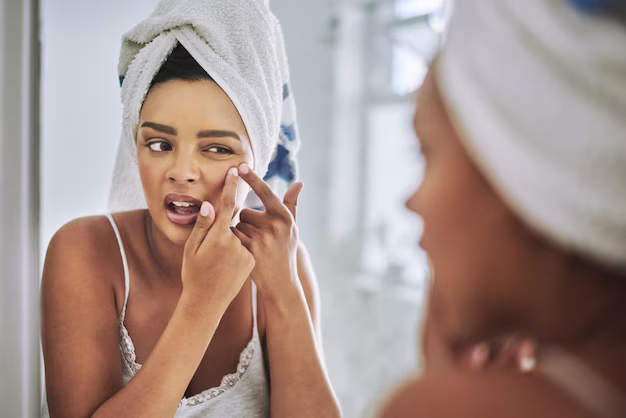Understanding and Managing Rosacea: Your Guide to Clearer Skin
Rosacea can be not only a skin condition but also a source of emotional distress. The flushed cheeks, visible blood vessels, and sometimes painful bumps can make social interactions or even a simple glance in the mirror challenging. But fear not; while an outright cure for rosacea hasn't been found yet, there are plenty of ways to manage it effectively and keep it under control. In this guide, we will explore various aspects of rosacea, empowering you with the knowledge you need to approach your skin’s needs with confidence.
What is Rosacea and How Does it Manifest?
Rosacea is a chronic skin condition characterized by facial redness, visible blood vessels, and sometimes acne-like bumps. It's more common in fair-skinned individuals but can affect anyone. The exact cause of rosacea remains unknown, but it's thought to involve a combination of hereditary and environmental factors.
Symptoms to Look For
- Facial Redness: The most common symptom, usually in the central part of the face.
- Visible Blood Vessels: Tiny blood vessels become visible on the nose and cheeks.
- Bumps and Pimples: Often mistaken for acne, these can be painful or irritated.
- Eye Problems: Some people experience dry, irritated eyes or swollen eyelids.
Triggers to Avoid
Managing rosacea often starts with identifying and avoiding common triggers. Triggers vary from one individual to another, but some are more prevalent among those with rosacea.
Common Triggers
- Sun Exposure: Overexposure to the sun is one of the most common culprits.
- Hot Beverages and Spicy Foods: These can cause flushing and trigger symptoms.
- Alcohol Consumption: Particularly red wine can exacerbate the condition.
- Temperature Extremes: Both hot and cold weather can lead to flare-ups.
- Stress and Emotional Upset: Anxiety and stress can worsen symptoms.
Being aware of your specific triggers can help you take proactive steps to prevent flare-ups. Many find it helpful to keep a diary of activities and flare-ups to identify patterns.
Skincare Routine for Rosacea
A proper skincare routine can make a significant difference in managing rosacea. The goal is to maintain a gentle routine that soothes and protects the skin barrier.
Daily Skincare Tips
- Use a Gentle Cleanser: Opt for fragrance-free, non-abrasive cleansers that soothe the skin.
- Moisturize Daily: Keeping the skin hydrated can prevent dryness and irritation.
- Protect from the Sun: Apply a broad-spectrum sunscreen with SPF 30 or higher every day.
- Avoid Harsh Exfoliants: Skip abrasive scrubs or harsh chemical peels.
Treatment Options
While there's no definitive cure for rosacea, several treatment options can help manage the condition. These range from lifestyle changes to medical treatments.
Non-Medical Treatments
- Laser Therapy: Can help reduce redness and visible blood vessels.
- Light Therapy: Some find relief with specific wavelengths of light therapy.
- Dietary Adjustments: Eliminate known dietary triggers.
Medications
Various medications can reduce symptoms and maintain clearer skin.
- Topical Treatments: Prescribed creams and gels can help reduce redness and inflammation.
- Oral Antibiotics: These can be effective for controlling redness and acne-like symptoms.
- Isotretinoin: In severe cases, this medication, commonly known for treating acne, may be prescribed.
Holistic Approaches to Rosacea Management
Beyond conventional treatments, many individuals look for holistic approaches to manage rosacea. While they aren't replacements for medical treatments, they may provide supplementary benefits.
Holistic Practices
- Mindfulness and Stress Reduction: Practices like yoga and meditation can help manage stress-related flare-ups.
- Aloe Vera: Known for its soothing properties, aloe vera can be applied to calm the skin.
- Green Tea Compresses: Topical green tea has been researched for its anti-inflammatory properties.
Navigating Emotional Challenges
Living with rosacea is not just about managing physical symptoms; it also involves addressing emotional well-being. The visible nature of rosacea can significantly impact self-esteem and confidence levels.
Emotional Support
- Join Support Groups: Connecting with others who understand the challenges of rosacea can be empowering.
- Professional Counseling: Speaking with a therapist can help manage anxiety and self-esteem issues.
- Mindfulness Practices: Incorporate practices that promote peace and self-acceptance.
Rosacea doesn’t define you, and taking steps towards emotional wellness is just as crucial as maintaining physical health.
Taking Control of Your Rosacea Journey
While managing rosacea can feel overwhelming, approaching it one step at a time can make the process more manageable. By understanding potential triggers, implementing an effective skincare routine, exploring treatment options, and nurturing your emotional health, you can take control of your rosacea journey and work towards clearer, more radiant skin.
Key Takeaways
- Identify Triggers: Recognize what exacerbates your rosacea and strive to avoid those factors.
- Develop a Skincare Routine: Use gentle, soothing products and always protect your skin from the sun.
- Explore Treatment Options: Consult with a professional to discuss suitable medications or therapies.
- Embrace Holistic Practices: Incorporate stress-reducing activities and consider natural remedies.
- Seek Emotional Support: Build a support network and explore mindfulness for well-being.
Quick Summary 📋
- Avoid Triggers: Recognize and steer clear of your personal triggers.
- Gentle Routine: Stick to mild cleansers and diligent moisturization.
- Sun Protection: Always include SPF in your skincare.
- Medications and Therapies: Consult healthcare professionals for tailored treatments.
- Holistic and Emotional Support: Engage in stress-relief activities and seek emotional support when needed.
By taking these steps, you can manage your rosacea effectively, fostering both physical comfort and emotional resilience. 🌟
